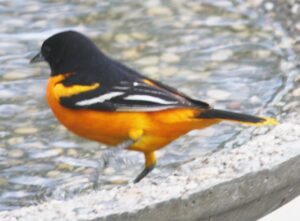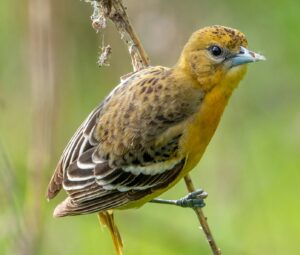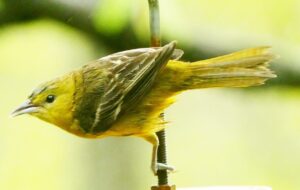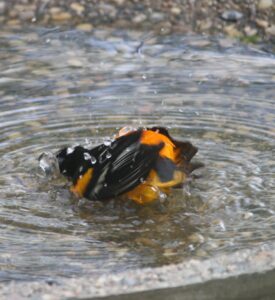For those of us in the northern and central states – where are the Baltimore Orioles?

If you have been watching the livestream bird bath cam since May, you will have seen lots of Baltimore Orioles eating, drinking, and bathing. You have probably noticed that in the last week, there were no Baltimore Orioles. We did have at 1 successful nest at our house and 1 at our neighbor’s across our small inlet. Baltimore Orioles seem to like to nest a few acres apart and where these nests were – that is about right. Both pairs of adults and their juveniles came to our oriole feeder you watched on the livestream to eat and to the bird bath to bathe and drink. But not now.
I am a big fan of the work of Donald W. Stokes and his wife Lillian Q. Stokes on bird behavior. They wrote several books on this subject: A Guide to Bird Behavior: Volumes 1, 2, and 3. Sadly, I think these 3 books are out of print and I base that on the fact I looked for them on my favorite book-buying websites and did not find them. However, they do appear on websites of used books. I recommend all 3 of these books. To be a birder, I think it is only scratching the surface to be a lister – even if your list is impressive. For me, the true essence of being a birder is also understanding birds, their behavior, their place in our world, and how they relate to us. How do they interact with each other, with other birds, with other species, with us? You can crank up the ole competitive juices by simply listing – who has more birds on their list – you or your birding friends? You or the people in your tour group? You or strangers you meet on the trail or on a park bench? And there can be satisfaction in that – a sense of accomplishment. And I am not making light of that. But for me, the real fascination comes with observing behavior. And a great place to begin with many species of birds is with these 3 books. Donald and Lillian Stokes have done wonderful work in exploring the behavior of birds and then explaining it to us. I used these 3 books, along with my own observations, to figure out what happened to these orioles.

We have not seen nor heard an oriole in over a week – and we know we had at least 12 using the Baltimore Oriole feeder and large bird bath several times a day. The Stokes write in their book that once the young fledge from the nest, it is most often the male that takes care of them and watches over them for about a week and then the young are on their own. We did observe this at the bird bath. The male was there with 3-4 juveniles several times a day. And this could have been 2 or more different males with different juveniles. We assume since we had 2 nests that it was at least those families – and there could have been more nests in other neighbors’ yards. We did not see the females during this time. As far as I know from reading, listening to lectures, and my own observations, here in central Illinois, Baltimore Orioles generally have only 1 brood each year – 2 is a rare exception.
Most of us – including me – assume the big migration months are September and October. As we learn more and more about birds, we may have learned that some birds can migrate as early as mid-August, but that was the exception. According to the Stokes, Baltimore Orioles are an exception as they start leaving their nesting grounds in mid-August and are in full migration in September. By the end of September they are generally all in their winter territories.
If you look at allaboutbirds.org from The Cornell Laboratory of Ornithology, type in Baltimore Oriole, and click on Maps, you will see orioles are more of a mid-distance migrator – some winter in Florida and the rest are on some of the Caribbean islands, in Central America, and northern South America. You will also read on this website that orioles can start migrating as early as July. This website has up-to-date research and observations from leading experts in the field of ornithology. The Stokes are also experts, but their books on behavior were published in the 1980’s. Things have changed. Baltimore Orioles are now beginning to migrate not in mid-August through September, but are now beginning in mid-July. That is a 4 week difference. And I am not the only one who has observed this.

One of the many emails I received was from Carol S. in Pittsburgh. PA. She wrote just this past week telling me she had several Baltimore Orioles all spring and early summer and now she has
none. She and her husband go out early each morning to sit and drink coffee and they are not seeing or hearing any. They do have their Merlin app on and Merlin does sometimes say it is hearing Baltimore Orioles, but they cannot confirm that. She also asked me if I thought maybe the orioles were quiet because they were molting. And she is right about that – this is the time of year that many songbirds molt and when they do, all are quieter. According to The Stokes, the female and juvenile orioles begin migrating while molting. The males generally stay in their nesting territories to complete their molt and then leave about a week or so after the females and juveniles. And orioles are not birds that travel hundreds of miles in a day and get to their wintering grounds in just a few days. The Stokes – and they are backed up by other experts – write that orioles ‘drift’. That most often means that these birds fly for a few hours – more or less – and then stop and rest for some time – maybe even several days or a week in an area depending on the availability of food, water, and trees. They are what I would call leisurely migrators. In human terms – sight-see-ers. Sunday drivers!

For us living here in central Illinois – along with many of you reading this – it has been a brutal summer in terms of temperature and humidity. Some of you may have seen me mowing this morning about 8AM central time and if I looked hot, that is because I was. I have hair that goes wild with humidity and this morning it was wild. You may not have noticed as I wear protective glasses and earphones, but believe me, it was wild when I took them off. And I don’t like to mow that early – people do like to sleep in. However, the man across the inlet from us cranked up his chainsaw at 7:30AM so I just added to the din. Right now, very early is the only time I can work outside and not feel like I am going to collapse with a heat stroke. And I am sure all of you experiencing these ‘heat domes’ agree with me. Has this excessive heat had anything to do with earlier migrations? That seems a contradiction to me as normally, the farther south a bird would travel, the hotter it would find the weather to be. However, these heat domes have made our temperatures as hot and our humidity as high or higher than anywhere in central and south Florida right now. And central and south Florida is where a good number of Baltimore Orioles have their winter territories. Orioles are leaving their nesting areas and starting their migrations to winter territories about 4 weeks earlier than they did 40 years ago and we have observed this in our neighborhood for the past 7 years. This is a change.
So where are the Baltimore Orioles? For us here in our yard, they are gone – all of them. For Carol S. in Pittsburgh, my guess is her females and juveniles are gone. In both places, these orioles have started their migration south to their winter territories. Their fall migration now begins in mid-July. If Merlin is correct (and it is not infallible – although this is a terrific app and a help to all birders!), then she might have a few males in the trees. I would be surprised if they were molting and singing at the same time. I have never known birds to do that. Of course, as soon as I say a bird never ….. I turn around and there is a bird doing exactly that. But molting and singing at the same time would be rare.
If any of you in our northern and central states are fortunate enough to have Baltimore Orioles in your yard or favorite park, are they still there? If you are in our southern states, are you starting to see these birds migrate through? If you use the Merlin app, what is it hearing? You can email me at lindahendricksspence@birdingbeyondthefieldguide.com.

